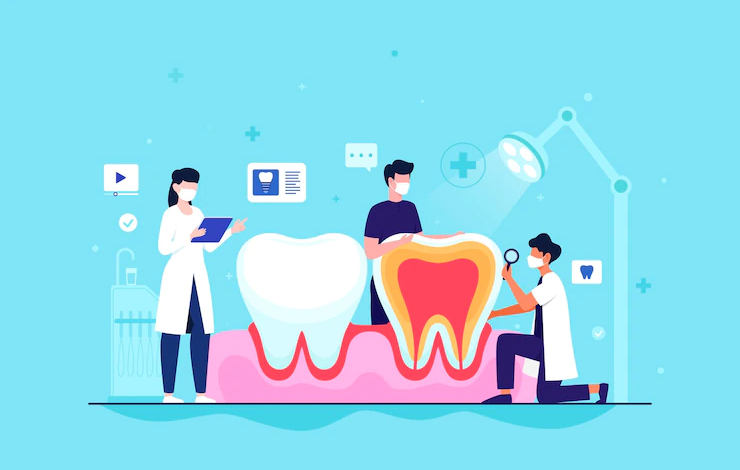Dental Website Design Guide For Growth

Your dental website is the virtual door of your Dental practice and the best tool for gaining and keeping patients. For this reason, you must do everything you can to properly optimize your dental website and make sure that it helps you achieve your goals.
If you are looking forward to improving your existing dental website or want to build it from scratch, then look no further. Below are the 5 key areas you need to focus on to improve your dental website design.

1) Demonstrate your expertise
The first and the most significant step to improve your dental website design is to ensure that your website demonstrates your knowledge in the medical field and expertise. You must include more trust signals to your website so that visitors can understand that you are the real deal. These signals include- showcasing your degree certificates, professional certificates, information about your credentials, expertise, and education on your homepage.
Secondly, make sure to add patients’ testimonials on your website. It is great if you can create a separate testimonial page, otherwise, you can also add a few testimonials on your homepage.
Thirdly, you may link to the external reviews of your practice. Suppose you have come across some great patient reviews on Google or Facebook, then ensure to link them directly on your homepage. By partnering with a reputed company providing top-quality web design services in India, you can add value to your dental website in the most effective way.

2) Make sure that your website is mobile-ready and responsive
Mobile phones now generate 54.8% of web traffic throughout the world. So having a mobile-friendly website is not only just an option, it is a must-have. Google now uses the mobile version of websites for indexing and ranking.
Mobile responsive design makes sure that your website looks perfect on all devices. It adjusts the layout and scales the text and images to fit the user’s screen. Also, a responsive website opens quickly and is easy to interact with.
A mobile-ready, user-friendly dental website design will encourage visitors to stay for a longer time on your website and help to elevate your ranking in the search results. On the other hand, if your website doesn’t load properly or is difficult to navigate, you can altogether lose a prospective patient and irritate your current ones.
A mobile responsive saves you from investing money in creating and maintaining multiple versions of your dental website.
3) Properly optimize your dental website on-page SEO
It is a fact that 93% of online experiences start with a search engine, and presently Google dominates the search engine market. So you will need to optimize your website as per the Google guidelines and improve the online visibility of your dental website. You also need to pay attention to some of the vital factors. They are as follows-
- Keywords: Well-targeted keywords are significant for dental SEO. The more semantically related your keywords will be, the more chances you will have of Google ranking your website. You will require separate pages if you want to rank for different keyword phrases.
- Website Speed: The amount of time your website takes to load and respond is one of the vital factors in determining your position in search. So try to improve the loading speed of your website. While external links are valuable, internal links too improve the website usability and its search engine desirability.
- Metadata: Make sure that your metadata descriptions include primary keywords and are unique. Also, make sure to add alt text, tags, and text descriptions for search engines to discover your web pages easily.
4) Create unique and compelling content for your website
Content is the backbone of a website. Posting blogs frequently helps to boost your website presence in search engines and drive more traffic to your website. In addition to that, a blog with engaging content also makes visitors stay on a website for a longer period and lower the bounce rate.
When you post an engaging blog filled with valuable information, more potential patients will come to your dental website. The blog will allow patients to start seeing you as an authority in dental care.
Furthermore, make sure to add relevant keywords to your blogs as well. This helps in boosting your SEO, ensuring that search engines are displaying your posts to the right audience. Also, always remain consistent in posting blog and post quality content that generates high-quality backlinks to your website.
5) Don’t forget to add CTA’s and Contact us page
Always add call-to-action buttons and contact-us-page on your website. This will have your clients understand where to move further to reach out to you.
a) Call-to-action buttons
Incorporating well-placed CTA buttons on a dental website act as a starter between patient and practitioner. These buttons help patients visiting your website take action by clicking on a link to book an appointment, explore additional treatment options, or download content. The CTA buttons also steer an interested patient in the proper direction to find the information they are looking for.
Effective CTA’s are one of the best SEO practices. Thus an attention-grabbing website design with clear CTA buttons can make your website stand out from the competition.
b) Contact Us Page
Creating a contact-us page is another best way to convert visitors into new patients. You can make visitors fill out a form on your website and collect their email addresses. No wonder you will get more responses than a simple contact us page and start creating an effective email marketing list.
Conclusion,
Your website is an important business tool. So it is important to devote the time and effort that your website deserves for website design and development. By using these tips you can create an effective dental website for your practice and reach your targeted audiences.
Apart from this if you are interested to know about A Complete Guide to Cracked Tooth then visit our Health category.




